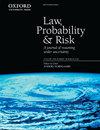Statistical issues arising in the Office of Federal Contract Compliance's recent notice on nondiscrimination obligations’ of contractor's and the concerns raised in the comments submitted by the U.S. Chamber of Commerce
IF 1.4
4区 社会学
Q1 LAW
引用次数: 0
Abstract
A proposed rule announced by the Office of Federal Contract Compliance describing the way statistical tests will be used in compliance reviews led to the Chamber of Commerce filing a formal Comment. The comment raises several statistical issues, including the proper analysis of stratified data and the effect of large samples on tests of significance. The Chamber correctly pointed out that simple pooling of the data into one large sample can lead to misleading conclusions, so an appropriate analysis, combining the results of statistical analyses of the individual strata into an overall estimate and statistical test is described. Both the proposal and Comment state that practical significance should be considered but do not provide a clear definition of the term, although various definitions are referred to. Two alternative approaches to evaluating the practical significance are described. One assesses the financial impact of the disparity on a typical wage earner, while the second considers the number of employees affected by the disparity and estimates the effect of the disparity on their earnings during their expected time of employment.联邦合同合规办公室最近关于承包商非歧视义务的通知中出现的统计问题,以及美国商会提交的评论中提出的关切
联邦合同合规办公室宣布的一项拟议规则描述了在合规审查中使用统计测试的方式,导致商会提交了正式意见。该评论提出了几个统计问题,包括分层数据的正确分析以及大样本对显著性测试的影响。分庭正确地指出,将数据简单地集中到一个大样本中可能会导致误导性结论,因此描述了一种适当的分析,将各个地层的统计分析结果结合到一个总体估计和统计测试中。提案和评论都指出,应考虑实际意义,但没有提供该术语的明确定义,尽管提到了各种定义。描述了评估实际意义的两种替代方法。其中一项评估了这种差异对典型工薪阶层的财务影响,而第二项则考虑了受这种差异影响的员工人数,并估计了这种差异在他们预期就业时间内对收入的影响。
本文章由计算机程序翻译,如有差异,请以英文原文为准。
求助全文
约1分钟内获得全文
求助全文
来源期刊

Law Probability & Risk
MATHEMATICSSTATISTICS & PROBABILITY&-STATISTICS & PROBABILITY
CiteScore
2.10
自引率
28.60%
发文量
8
期刊介绍:
Law, Probability & Risk is a fully refereed journal which publishes papers dealing with topics on the interface of law and probabilistic reasoning. These are interpreted broadly to include aspects relevant to the interpretation of scientific evidence, the assessment of uncertainty and the assessment of risk. The readership includes academic lawyers, mathematicians, statisticians and social scientists with interests in quantitative reasoning.
The primary objective of the journal is to cover issues in law, which have a scientific element, with an emphasis on statistical and probabilistic issues and the assessment of risk.
Examples of topics which may be covered include communications law, computers and the law, environmental law, law and medicine, regulatory law for science and technology, identification problems (such as DNA but including other materials), sampling issues (drugs, computer pornography, fraud), offender profiling, credit scoring, risk assessment, the role of statistics and probability in drafting legislation, the assessment of competing theories of evidence (possibly with a view to forming an optimal combination of them). In addition, a whole new area is emerging in the application of computers to medicine and other safety-critical areas. New legislation is required to define the responsibility of computer experts who develop software for tackling these safety-critical problems.
 求助内容:
求助内容: 应助结果提醒方式:
应助结果提醒方式:


